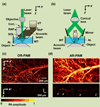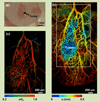Photoacoustic tomography: principles and advances
- PMID: 25642127
- PMCID: PMC4311576
- DOI: 10.2528/pier14032303
Photoacoustic tomography: principles and advances
Abstract
Photoacoustic tomography (PAT) is an emerging imaging modality that shows great potential for preclinical research and clinical practice. As a hybrid technique, PAT is based on the acoustic detection of optical absorption from either endogenous chromophores, such as oxy-hemoglobin and deoxy-hemoglobin, or exogenous contrast agents, such as organic dyes and nanoparticles. Because ultrasound scatters much less than light in tissue, PAT generates high-resolution images in both the optical ballistic and diffusive regimes. Over the past decade, the photoacoustic technique has been evolving rapidly, leading to a variety of exciting discoveries and applications. This review covers the basic principles of PAT and its different implementations. Strengths of PAT are highlighted, along with the most recent imaging results.
Keywords: Photoacoustic tomography; anatomical imaging; brain imaging; functional imaging; molecular imaging; nanoparticle; photoacoustic computed tomography; photoacoustic microscopy; super resolution; tumor imaging; vascular imaging.
Figures









References
-
- Zhang HF, Maslov K, Stoica G, Wang LV. Functional photoacoustic microscopy for high-resolution and noninvasive in vivo imaging. Nat Biotech. 2006;24:848–851. - PubMed
-
- Fang H, Maslov K, Wang LV. Photoacoustic Doppler effect from flowing small light-absorbing particles. Physical Review Letters. 2007 Nov 2;99:184501. - PubMed
Grants and funding
LinkOut - more resources
Full Text Sources
Other Literature Sources
Molecular Biology Databases
Research Materials
Miscellaneous
